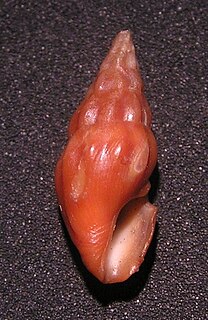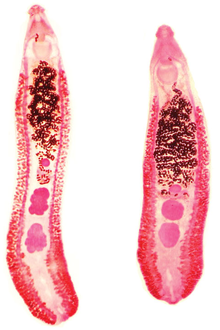
Digenea is a class of trematodes in the Platyhelminthes phylum, consisting of parasitic flatworms with a syncytial tegument and, usually, two suckers, one ventral and one oral. Adults commonly live within the digestive tract, but occur throughout the organ systems of all classes of vertebrates. Once thought to be related to the Monogenea, it is now recognised that they are closest to the Aspidogastrea and that the Monogenea are more closely allied with the Cestoda. Around 6,000 species have been described to date.

Siphonostomatoida is an order of copepods, containing around 75% of all the copepods that parasitise fishes. Their success has been linked to their possession of siphon-like mandibles and of a "frontal filament" to aid attachment to their hosts. Most are marine, but a few live in fresh water. There are 39 recognised families:

The family Argulidae contains the carp lice or fish lice – a group of parasitic crustaceans of uncertain position within the Maxillopoda. Although they are thought to be primitive forms, they have no fossil record. The Argulidae are the only family in the order Arguloida, although a second family, the Dipteropeltidae, has been proposed.

The thorny-headed worm family Polymorphidae contains endoparasites which as adults feed mainly in fish and aquatic birds. When this taxon was erected by Meyer in 1931, a subfamily Polymorphinae was established in it. As the Polymorphidae as presently understood would then be monotypic, with no basal genera outside the Polymorphinae, the proposed subfamily is redundant for the time being and therefore most modern treatments simply omit it. Polymorphus minutus is an economically significant parasite in goose and duck farming.

Plagiorchiida is a large order of trematodes, synonymous to Echinostomida. They belong to the Digenea, a large subclass of flukes. This order contains relatively few significant parasites of humans.

Drillia is a genus of small sea snails, marine gastropod mollusks in the family Drilliidae.

Opisthorchiidae is a family of digenean trematodes. Opisthorchiidae have cosmopolitan distribution.

Microcotyle is a genus which belongs to the phylum Platyhelminthes and class Monogenea. Species of Microcotyle are ectoparasites that affect their host by attaching themselves as larvae on the gills of the fish and grow into adult stage. This larval stage is called oncomiracidium, and is characterized as free swimming and ciliated.
Apocreadiidae is a family of parasitic worms in the class Trematoda.

Opecoelidae is a family of trematodes. It is the largest digenean family with over 90 genera and nearly 900 species, almost solely found in marine and freshwater teleost fishes. It was considered by Bray et al. to belong in the superfamily Opecoeloidea Ozaki, 1925 or the Brachycladioidea Odhner, 1905.

Philometra is a genus of nematodes, which are parasites of marine and freshwater fishes. The genus was erected by Oronzio Gabriele Costa in 1845.
Telorchiidae is a family of trematode parasites.
Plotnikovia is a Zoological name in need of resolution.
Neonotoporus is a genus of trematodes in the family Opecoelidae.

Echinostomatidae is a family of trematodes in the order Plagiorchiida, first described in 1899.
Azygiida is an order of flatworms belonging to the class Rhabditophora.
Acanthoparyphium is a genus of flatworms belonging to the family Himasthlidae.
Renicola is a genus of flatworms belonging to the family Renicolidae.
Halipegus is a genus of trematode in the family Derogenidae.











